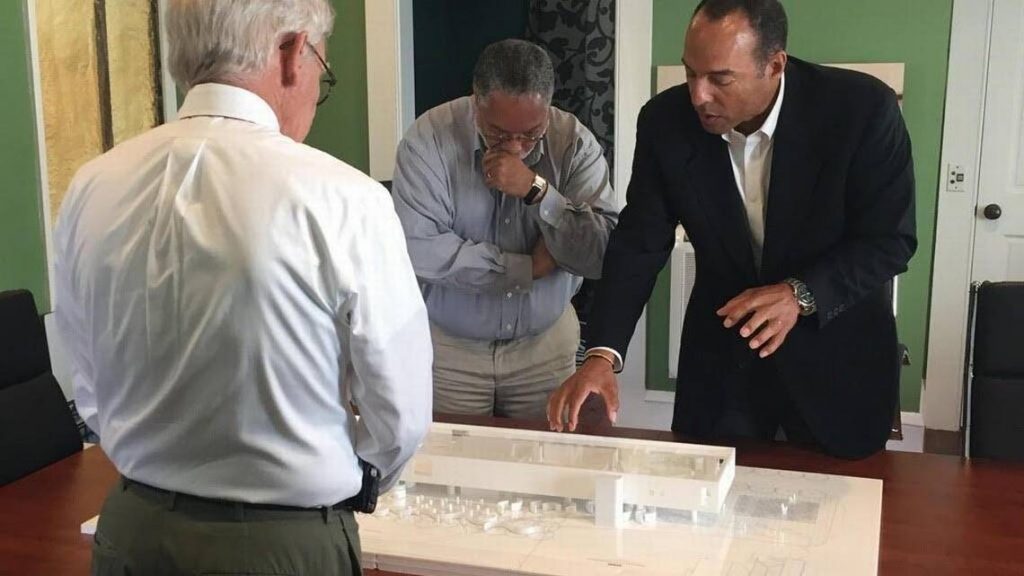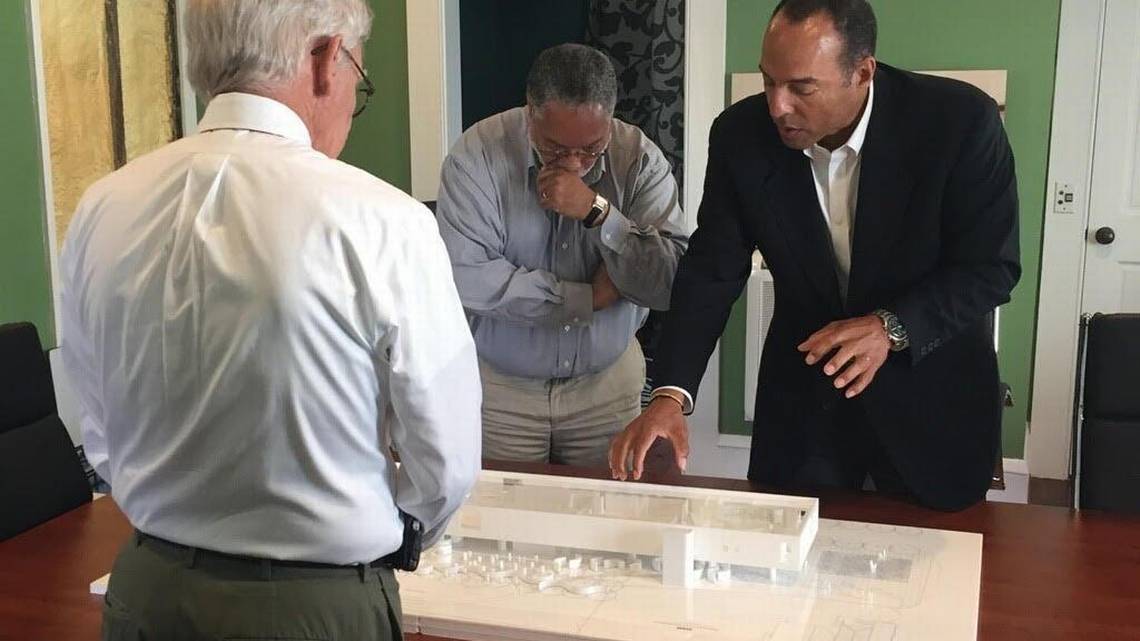
Michael Boulware Moore, president and CEO of the International African American Museum, Former Charleston Mayor Joseph P. Riley, Jr., and Lonnie Bunch, director of the National Museum of African American History and Culture, view the architectural model of the International African American Museum in Charleston. Provided by the International African American Museum
By the time South Carolina celebrates its next Black History Month, construction of the historic International African American Museum should be underway.
The long-planned Charleston museum is slated to break ground this summer. Its opening is scheduled for 2020, focusing global attention on what was once the epicenter of the North American slave trade.
“It’s rare for a small city to be able to give such a gift to the entire nation,” said Michael Boulware Moore, president of the museum.
The museum had something of a fundraising boom in 2017, pulling in $14 million in private donations. That includes a record $10 million gift from the Lilly Foundation, among other large corporate and individual donations.
Museum officials say they are less than $6 million away from their $25 million private fundraising goal. That is a third of the museum’s estimated cost. The state of South Carolina already has appropriated $14 million toward its third of the funds. The city and county of Charleston have pledged a combined $25 million.
Built on the site of Gadsden’s Wharf along the Cooper River, the museum will mark the spot where an estimated half of all slaves who entered the United States first set foot on American soil. In its impact on African-American history, the site has been compared to Ellis Island.
“Just about every African-American has a relative who arrived in Charleston,” Moore said. “There’s a connection with our first American ancestors.”
DC museum ‘created more interest’
Interest in the museum has soared since the 2016 opening of the National Museum of African American History and Culture at the Smithsonian Institution in Washington, D.C.
“The launch of the national museum increased awareness of what (the S.C. museum) could be like,” Moore said. “We were concerned the museum would suck up all the oxygen for African-American history, but it created more interest.”
Former Charleston Mayor Joe Riley, a longtime advocate for the museum, recalls a Smithsonian official telling him, “In D.C., we’re creating history. But, down here, you have it.”
“It’s important to have this where that history occurred,” said Riley, who refers to the former Gadsden’s Wharf as a “sacred site.”
“Because if not, it shows that you don’t think it’s that important.”
Riley, who was Charleston’s mayor from 1975 to 2015, first suggested the idea for the museum at his 2000 inauguration. At the time, “how long it would take, I had no way of knowing,” he now acknowledges.
Now on the museum’s board, Riley credits the idea for the museum to reading the 1998 book “Slaves in the Family,” in which writer Edward Ball attempted to trace the descendants of the African-Americans once owned by his family on a S.C. plantation.
“I realized my ignorance” of just how long and deep slavery’s impact on Charleston was, Riley recalled, “in common with other Southerners and Americans.”
The former mayor now calls the museum a “passion” that he is worked on every day since his retirement from City Hall. Having the support of someone of Riley’s stature has been a major benefit for the upstart museum, according to Moore.
“His Rolodex is deep, and he’s mining that Rolodex,” Moore said.
‘Leverage history to contribute to … today’
Once completed, the museum will cover 40,000 square feet, slightly larger than a football field. It will be raised about 14 feet off the ground on pillars and surrounded by a public garden.
The east side will be filled with galleries on specific subjects, such as the role of slavery in the Atlantic world, the coast’s Gullah-Geechee heritage, and African history and cultures. At the center of the east wing will be an interactive multimedia table that will operate like a touchscreen.
On the west side, a linear history of African-Americans will be told in a U-shaped space, with the central area reserved for special or traveling exhibits that will change regularly.
The museum is being designed by architects Moody Nolan and the design firm of Pei Cobb Freed. Its exhibit will be created by Ralph Appelbaum, who also worked on the U.S. Holocaust Memorial Museum and the Barack Obama presidential library. The landscape will be designed by Walter Hood of the University of California at Berkeley.
In addition, the museum will have a social justice action center that will host documentary screenings, lectures and conferences on how “we can leverage history to contribute to social justice issues today.”
The museum’s Center for Family History will assist African-Americans in reconstructing a family tree, even tracing their genealogy beyond what Moore calls the “brick wall” of 1870.
“Prior to the 1870 census, most African-Americans weren’t listed by their full names,” Moore said. “It would only list that someone owned 10 men, eight women and three children.”
Once the museum completes its initial fundraising work, organizers hope to start building a $25 million endowment, eventually expanding the museum’s staff to about 40 full-time employees in time for the late 2020 opening.



